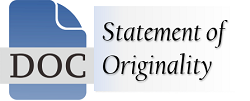High School Students’ Perceptions Of Gerakan Literasi Sekolah
DOI:
https://doi.org/10.31599/pees1565Keywords:
Mobilization, Perception, School Literacy MovementAbstract
Gerakan Literasi Sekolah or GLS is a government-led movement through the Ministry of Education and Culture to organize literacy activities throughout school education. GLS focuses on developing character through reading book material by cultivating a literacy ecosystem at school. The purpose of the study was to determine the impact of GLS through students' understanding and perceptions of the program that has been undertaken. The approach method used in this research is descriptive qualitative data collection through teacher and student interviews at one of the high schools in Boyolali. The results showed that GLS is the result of policy mobilization from the government, with the issuance of Permendikbud Number 15 of 2015, which requires every school to organize GLS, and students are inevitably needed to carry out the regulation. In general, GLS in Indonesia is still at the stage of growing interest in reading. However, in its implementation, literacy is not implemented by the guidelines. The purpose of literacy still needs to be achieved as it should be. Students' perceptions and paradigms on literacy still include the meaning of reading and writing activities, students' awareness of reading needs to be improved, and GLS needs to be optimally integrated with GLK and GLM. However, overall, the school has been quite good in starting the stages of implementing GLS in their school.
Downloads
References
Adawiyah, L., & Gunansyah, G. (2018). Persepsi Guru Terhadap Pelaksanaan Gerakan Literasi Di Sekolah Dasar Negeri Terakreditasi A Kota Surabaya. Jurnal Penelitian Pendidikan Guru Sekolah Dasar, 6(4), 1–10.
Ahyar, H., Maret, U. S., Andriani, H., Sukmana, D. J., Mada, U. G., Hardani, S.Pd., M. S., Nur Hikmatul Auliya, G. C. B., Helmina Andriani, M. S., Fardani, R. A., Ustiawaty, J., Utami, E. F., Sukmana, D. J., & Istiqomah, R. R. (2020). Buku Metode Penelitian Kualitatif & Kuantitatif (Issue March).
Anggraini, S., Siswanto, J., & Sukamto. (2019). Analisis Dampak Pemberian Reward And Punishment Bagi Siswa SD Negeri Kaliwiru Semarang. Jurnal Mimbar PGSD Undiksha, 7(3), 221–229.
Asopwan, D. (2018). Studi Tentang Akreditasi Dalam Meningkatkan Produktivitas Sekolah. Indonesian Journal of Education Management and Administration Review, 2(2), 264–271.
Azriansyah, Istiningsih, S., & Setiawan, H. (2021). Analisis Hambatan Guru Dalam Pelaksanaan Gerakan Literasi Sekolah (GLS) Di SDN 32 Cakranegara. Renjana Pendidikan Dasar, 1(4), 262–269. http://prospek.unram.ac.id/index.php/renjana/article/view/161
Badan Pusat Statistik. (2022). Indeks Pembangunan Manusia. In Badan Pusat Statistik. https://tanjabtimkab.bps.go.id/subject/26/indeks-pembangunan-manusia.html
BPS. (2016). Persentase Penduduk Umur 10 Tahun Ke Atas Menurut Jenis Kelamin, dan Kemampuan Baca Tulis, 2015-2016 (Jiwa), 2016. https://barutkab.bps.go.id/indicator/27/309/1/persentase-penduduk-umur-10-tahun-ke-atas-menurut-jenis-kelamin-dan-kemampuan-baca-tulis-2015-2016.html
Gunawardena, M. (2017). The Implications of Literacy Teaching Models. International Journal of Education and Literacy Studies, 5(1), 94. https://doi.org/10.7575/aiac.ijels.v.5n.1p.94
Ilham Junaid. (2016). P3M Politeknik Pariwisata Makassar Analisis Data Kualitatif Dalam Penelitian Pariwisata. Jurnal Kepariwisataan, 10(01), 59–74.
Kementerian Pendidikan dan Kebudayaan. (2017). Peta Jalan Gerakan Literasi Nasional (pp. 1–51).
Kementerian Pendidikan dan Kebudayaan Jakarta. (2017). Panduan Gerakan Literasi Nasional. Panduan Gerakan Literasi Nasional, 50. https://gln.kemdikbud.go.id/glnsite/wp-content/uploads/2017/08/panduan-gln.pdf
Khotimah, K., Akbar, S., & Sa’dijah, C. (2018). Pelaksanaan Gerakan Literasi Sekolah. Jurnal Pendidikan, 3(11), 1488–1498.
Martiningsih. (n.d.). Partisipasi Siswa Dalam Implementasi Gerakan Literasi. 223–229.
Maryani, L., & Sopiansah, V. A. (2019). Minat Belajar Siswa dengan Variasi Penggunaan Media Pembelajaran (Survey pada Siswa Jurusan Akuntansi di SMK Negeri 3 Bandung). Jurnal Petik, 5(1), 63–69. https://doi.org/10.31980/jpetik.v5i1.473
Nopilda, L., & Kristiawan, M. (2018). Gerakan Literasi Sekolah Berbasis Pembelajaran Multiliterasi Sebuah Paradigma Pendidikan Abad Ke- 21. JMKSP (Jurnal Manajemen, Kepemimpinan, Dan Supervisi Pendidikan), 3(2). https://doi.org/10.31851/jmksp.v3i2.1862
OECD. (2019). How does PISA define and measure reading literacy? PISA in Focus, No.101.
Prasrihamni, M., Zulela, & Edwita. (2022). Optimalisasi Penerapan Kegiatan Literasi Dalam Meningkatkan Minat Baca Siswa Sekolah Dasar Mega. Jurnal Cakrawala Pendas, 8(1), 128–134.
Pribadi, R. A., Simanullang, M. R., & Karimah, S. N. (2021). Analisis Strategi Penguatan Disiplin Belajar Siswa SD Melalui Metode Reward dan Punishment. Jurnal Pendidikan Tambusai, 5(2020), 9564–9571.
Ramandanu, F. (2019). Gerakan Literasi Sekolah (Gls) Melalui Pemanfaatan Sudut Baca Kelas Sebagai Sarana Alternatif Penumbuhan Minat Baca Siswa. Mimbar Ilmu, 24(1), 10. https://doi.org/10.23887/mi.v24i1.17405
Robbins, P. S. (2008). Organizational Behavior, Tenth Edition (Perilaku Organisasi ke Sepuluh) (Alih Bahasa : Drs. Benyamin Molan (ed.); Keenam). Salemba Empat: Jakarta.
Sari, C. P. (2018). Faktor-Faktor Penyebab Rendahnya Minat Membaca Siswa Kelas IV. Jurnal Pendidikan Guru Sekolah Dasar, 7(32), 3128–3137. http://journal.student.uny.ac.id/ojs/ojs/index.php/pgsd/article/viewFile/13875/13400
Sari, D. K. (2017). Strategi Mobilisasi Gerakan Masyarakat Dalam Penutupan Industri Pengelolaan Limbah B3 Di Desa Lakardowo Kabupaten Mojokerto. Jurnal Politik Indonesia, 2, 127–134.
Septiary, D., & Sidabutar, M. (2020). Pelaksanaan program gerakan literasi sekolah (GLS) di SD Muhammadiyah Sokonandi. Epistema, 1(1), 1–12. https://doi.org/10.21831/ep.v1i1.32054
Subaktiar, M. I. (2020). Gerakan Mahasiswa dalam Novel Lelaki Di Tengah Hujan Karya Wenri Wanhar ( Kajian Mobilisasi Sumber Daya ). Jurnalmahasiswa.Unesa, 7(4), 10. https://jurnalmahasiswa.unesa.ac.id/index.php/bapala/article/view/35016
Sukmana, O. (2016). Konsep Dan Teori Gerakan Sosial. In Intrans Publishing.
Summaries, C. E. (2019). What Students Know and Can Do. PISA 2009 at a Glance, I. https://doi.org/10.1787/g222d18af-en
Sutrianto, Rahmawan, N., Hadi, S., & Fitriono, H. (2016). Panduan Gerakan Literasi Sekolah di Sekolah Menengah Atas. Direktorat Pembinaan Sekolah Menengah Atas Direktorat Jenderal Pendidikan Dasar Dan Menengah Kementerian Pendidikan Dan Kebudayaan, v+40.
Trianggoro, I. R. W., & Koeswanti, H. D. (2021). Evaluasi Program Gerakan Literasi Sekolah (Gelis) Di Sekolah Dasar. Jurnal Ilmiah Pendidikan Profesi Guru, 4(3), 355–362.
Yusrawati JR. (2020). Analisis Siswa SMP Di Bandaa Aceh Tentang Literasi. Prosiding Seminar Nasional Pendidikan, 8(75), 66–79.











_-_Copy1.jpg)




